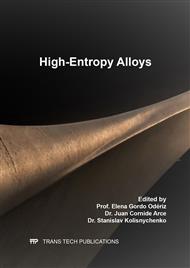[1]
J.W. Yeh, S.K. Chen, S.J. Lin, J.Y. Gan, T.S. Chin, T.T. Shun, C.H. Tsau, S.Y. Chang, Nanostructured high-entropy alloys with multiple principal elements: novel alloy design concepts and outcomes, Adv. Eng. Mater. 6 (2004) 299-303.
DOI: 10.1002/adem.200300567
Google Scholar
[2]
D.B. Miracle, J.D. Miller, O.N. Senkov, C. Woodward, M.D. Uchic, J. Tiles, Exploration and development of high entropy alloys for structural applications, Entropy 16 (2014) 494-525.
DOI: 10.3390/e16010494
Google Scholar
[3]
Z. Zou, H. Ma, R. Spolenak, Ultrastrong ductile and stable high-entropy alloys at small scales, Nature Communications 6 (2015) 1-6.
DOI: 10.1038/ncomms8748
Google Scholar
[4]
L. Lilensten, J.P. Couzinié, L. Perrière, J. Bourgon, N. Emery, I. Guillot, New structure in refractory high-entropy alloys, Materials Letters 132 (2014) 123-125.
DOI: 10.1016/j.matlet.2014.06.064
Google Scholar
[5]
G. Dirras, J. Gubicza, A. Heczel, L. Lilenstein, J. -P. Couzinié, L. Perrière, Y. Guillot, A. Hocini, Microstructural investigation of plastically deformed Ti20Zr20Hf20Nb20Ta20 high entropy alloy by X-ray diffraction and transmission electron microscopy, Mater. Char. 108 (2015).
DOI: 10.1016/j.matchar.2015.08.007
Google Scholar
[6]
T.G. Langdon, Twenty-five years of ultrafine-grained materials: Achieving exceptional properties through grain refinement, Acta Materialia, 61 (2013) 7035-7059.
DOI: 10.1016/j.actamat.2013.08.018
Google Scholar
[7]
R.Z. Valiev, A.P. Zhilyaev, T.G. Langdon, Bulk Nanostructured Materials, Fundamentals and Applications, John Wiley & Sons, Inc., Hoboken, New Jersey, (2014).
Google Scholar
[8]
A.P. Zhilyaev, T.G. Langdon, Using high-pressure torsion for metal processing: Fundamentals and applications, Progress in Materials Science, 53 (2008) 893-979.
DOI: 10.1016/j.pmatsci.2008.03.002
Google Scholar
[9]
R.B. Figueiredo, P.H.R. Pereira, M.T.P. Aguilar, P.R. Cetlin, T.G. Langdon, Using finite element modelling to examine the flow processes in quasi-constrained high-pressure torsion, Acta Materialia, 60 (2012) 3190-3198.
DOI: 10.1016/j.actamat.2012.02.027
Google Scholar
[10]
J. Nelson, D. Riley, An experimental investigation of extrapolation methods in the derivation of accurate until-cell dimensions of crystals, Proc. Phys. Soc. Lond. 57 (1945) 160-177.
DOI: 10.1088/0959-5309/57/3/302
Google Scholar
[11]
S. Banumathy, R. K. Mandal, A. K. Singh: Structure of orthorhombic martensitic phase in binary Ti–Nb alloys, J. Appl. Phys. 106 (2009) 093518.
DOI: 10.1063/1.3255966
Google Scholar
[12]
D. Tabor, The Hardness of Metals, Oxford University Press, New York, (1951).
Google Scholar



